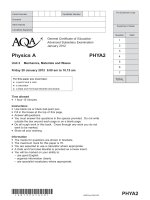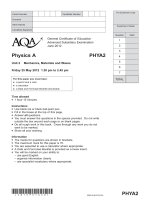AQA PHA6B6X QP JUN13
Bạn đang xem bản rút gọn của tài liệu. Xem và tải ngay bản đầy đủ của tài liệu tại đây (556.98 KB, 12 trang )
Centre
Number
Candidate
Number
Surname
Other
Names
For Examiner’s Use
Notice to Candidate. The work you submit for assessment must be your own. If you copy from someone
else or allow another candidate to copy from you, or if you cheat in any other way, you may be disqualified.
Candidate Declaration. I have read and understood the Notice to Candidate and can confirm that
I have produced the attached work without assistance other than that which is acceptable under the scheme
of assessment.
Candidate
Signature
Date
Section
Mark
Section A
Task 1 Q1
General Certificate of Education
Advanced Level Examination
June 2013
Physics
(Specifications A and B)
Examiner’s Initials
PHA6/B6/X
Unit 6
Investigative and Practical Skills in A2 Physics
Route X Externally Marked Practical Assignment (EMPA)
Section B
Written Test
Section A
Task 1 Q2
Section A
Task 2 Q1
Section B
Q1
Section B
Q2
Section B
Q3
TOTAL
For this paper you must have:
l your completed Section A Task 2 question paper /
answer booklet.
l a ruler
l a pencil
l a calculator.
Instructions
l Use black ink or black ball-point pen.
l Fill in the boxes at the top of this page.
l Answer all questions.
l You must answer the questions in the space provided. Do not
write outside the box around each page or on blank pages.
l Show all your working.
l Do all rough work in this book. Cross through any work you do
not want to be marked.
Time allowed
l 1 hour 15 minutes
Information
l The marks for questions are shown in brackets.
l The maximum mark for this paper is 23.
Details of additional assistance (if any). Did the candidate receive any help or information in the production of this
work? If you answer yes, give the details below or on a separate page.
Yes
No
Practical Skills Verification
Teacher Declaration: I confirm that the candidate has met the
requirement of the practical skills verification (PSV) in accordance
with the instructions and criteria in section 3.8 of the specification.
Yes
Signature of teacher ................................................................................................................... Date ..........................................
As part of AQA’s commitment to assist students, AQA may make your coursework available on a strictly anonymous basis to teachers,
examining staff and students in paper form or electronically, through the Internet or other means, for the purpose of indicating a typical mark
or for other educational purposes. In the unlikely event that your coursework is made available for the purposes stated above, you may
object to this at any time and we will remove the work on reasonable notice. If you have any concerns please contact AQA.
To see how AQA complies with the Data Protection Act 1988 please see our Privacy Statement at aqa.org.uk.
WMP/Jun13/PHA6/B6/X
PHA6/B6/X
2
There are no questions printed on this page
DO NOT WRITE ON THIS PAGE
ANSWER IN THE SPACES PROVIDED
WMP/Jun13/PHA6/B6/X
3
Do not write
outside the
box
Section B
Answer all the questions in the spaces provided. Time allowed 1 hour 15 minutes.
You will need to refer to the work you did in Section A Task 2 when answering these questions.
1 (a)
1
1
Determine the gradient, G, of your graph of log –––
– –––
against log d.
2
T
T02
(
)
.............................................................................................................................................
.............................................................................................................................................
.............................................................................................................................................
G = ..................................................................
(4 marks)
1 (b)
It is suggested that the period is related to the distance by the expression
1
1
––– – ––– = kdn ,
2
T
T02
where k is a constant and n is an integer.
1 (b) (i) Deduce the value of n.
n = ..................................................................
1 (b) (ii) Deduce the unit for k.
.............................................................................................................................................
.............................................................................................................................................
.............................................................................................................................................
1 (b) (iii) State and explain how you could use your graph to deduce the numerical value of k.
.............................................................................................................................................
.............................................................................................................................................
.............................................................................................................................................
.............................................................................................................................................
.............................................................................................................................................
.............................................................................................................................................
(4 marks)
Turn over ᮣ
WMP/Jun13/PHA6/B6/X
8
4
2
Do not write
outside the
box
In Section A Task 1 you observed the energy transfer between masses M3 and M4
suspended by springs from a horizontal metre ruler using the apparatus shown in
Figure 7.
Figure 7
d
horizontal arm
of clamp
mass M3
mass M4
With the same apparatus, a student investigates how d, the horizontal distance between
the arms of the clamps on which the metre ruler is supported, affects τ, the time of
energy transfer between M3 and M4 .
The student measured the times for n energy transfers between the masses, as shown in
Table 2.
Table 2
d / cm
n
nτ/s
nτ/s
86.0
6
212
209
78.0
5
236
240
70.0
6
408
*
65.0
4
347
*
τ/s
* only one set of readings of n τ was completed for these values of d
2 (a) (i) Complete Table 2 to show the values for τ that the student obtained.
2 (a) (ii) Justify the number of significant figures you have given for the values of τ.
..............................................................................................................................................
..............................................................................................................................................
(2 marks)
WMP/Jun13/PHA6/B6/X
5
2 (b)
Do not write
outside the
box
1
The student claimed that these results showed that τ was directly proportional to –––
.
d2
Analyse the data in Table 2 to show whether the student’s claim is correct.
.............................................................................................................................................
.............................................................................................................................................
.............................................................................................................................................
.............................................................................................................................................
.............................................................................................................................................
.............................................................................................................................................
.............................................................................................................................................
.............................................................................................................................................
(2 marks)
2 (c)
Suggest three valid control variables for the experiment.
1 ..........................................................................................................................................
2 ..........................................................................................................................................
3 ..........................................................................................................................................
(1 mark)
THE QUESTION IS CONTINUED ON THE NEXT PAGE
Turn over ᮣ
WMP/Jun13/PHA6/B6/X
6
2 (d)
Do not write
outside the
box
In a different experiment to illustrate energy transfer between oscillators, three bar
magnets are arranged as shown in Figure 8.
Figure 8
magnet B
magnet C
magnet A
sheet of paper to prevent
magnets B and C slipping
magnet B is set in oscillation
oscillating motion is transferred to magnet C
Magnets B and C are balanced on one edge using the repulsion produced by magnet A,
the paper below providing friction to prevent B and C slipping.
When B is set oscillating about the point of contact with the paper, the oscillating
motion is transferred within a few cycles to C, and then back again, as in your
experiment with masses M3 and M4 .
A student uses a motion sensor and a data logger to record the motion of magnet B; the
data are then exported to a computer and analysed using a spreadsheet.
Figure 9 is based on 25 000 measurements that are transferred to the data logger in
10 seconds and shows how the displacement, y, of the moving end of magnet B, varies
with time, t.
Figure 9
5
4
3
2
1
y / mm
0
–1
–2
–3
–4
–5
WMP/Jun13/PHA6/B6/X
0
2
4
t/s
6
8
10
7
Do not write
outside the
box
2 (d) (i) What was the sample rate of the data logger when the data displayed in Figure 9 was
being recorded?
sample rate = ......................................................................................................................
The sample rate is then changed so that 25 000 measurements are transferred to the
data logger in 250 seconds. These results are displayed in Figure 10.
Figure 10
5
4
3
2
1
y / mm 0
–1
–2
–3
–4
–5
0
50
100
t/s
150
200
250
2 (d) (ii) If τ = the time for energy transfer from magnet B to magnet C and back again to B,
and T = the period of oscillations of magnet B, use Figure 9 and Figure 10 to
τ
determine ––.
T
You may assume that in both Figure 9 and 10, y has just reached a maximum value
at t = 0.
.............................................................................................................................................
.............................................................................................................................................
.............................................................................................................................................
.............................................................................................................................................
τ = .............................................................................................
––
T
(4 marks)
9
Turn over ᮣ
WMP/Jun13/PHA6/B6/X
8
3
Do not write
outside the
box
In Section A Task 1 you used a compass to investigate how the magnetic flux
density varies between two bar magnets. One magnet was positioned on a metre ruler,
aligned east-west, and the other on a half-metre ruler, aligned north-south.
A student, performing this experiment, sees that when the magnet on the half-metre
ruler is removed the compass needle rotates through an angle θ, as shown in Figure 11.
The student notices that when the remaining magnet is moved along the metre ruler so
that the distance x defined in Figure 11, is reduced, θ increases.
Figure 11
N
half-metre
ruler
W
E
θ
S
metre ruler
bar magnet
N
x
compass
WMP/Jun13/PHA6/B6/X
9
Do not write
outside the
box
A teacher explains that B, the magnetic flux density due to the bar magnet at the
plotting compass, is given by B = B0 tan θ.
B0 is the horizontal component of the ambient magnetic flux density (ie due to the
surroundings) and is known to be 1.8 × 10–5 T.
3
(a) Describe how the student could investigate how B varies with x, the distance along the
metre ruler from the end of the magnet to the centre of the compass.
Your answer should:
l explain how the student should make the necessary measurements to determine
B and x; you may wish to add detail to Figure 11 to illustrate this part of your
answer
l explain any relevant procedure that will reduce systematic error in the results
for B
l explain how the measurements will be used to determine how B varies with x.
.............................................................................................................................................
.............................................................................................................................................
.............................................................................................................................................
.............................................................................................................................................
.............................................................................................................................................
.............................................................................................................................................
.............................................................................................................................................
.............................................................................................................................................
.............................................................................................................................................
.............................................................................................................................................
.............................................................................................................................................
.............................................................................................................................................
.............................................................................................................................................
.............................................................................................................................................
(3 marks)
THE QUESTION IS CONTINUED ON THE NEXT PAGE
Turn over ᮣ
WMP/Jun13/PHA6/B6/X
10
3
Do not write
outside the
box
(b) The teacher shows the student an instrument called a deflection magnetometer and
suggests that this could be used in place of the compass to reduce uncertainty in the
measurement of θ.
A deflection magnetometer, as seen from above, is shown in Figure 12 and consists
of a magnet pivoted at the centre of a rotary scale. A long pointer is mounted at right
angles to the magnet and a mirror is set into the dial. A plotting compass is shown to
the same scale so a comparison can be made with the size of the magnetometer.
20
mirror set into
the dial of the
magnetometer
40
32
0
0
340
Figure 12
60
300
needle
280
80
260
100
magnet
240
120
0
14
22
compass shown
to same scale
0
160
180
200
State and explain two features of the design of the magnetometer that help to reduce
uncertainty in the measurement of θ.
first feature:
.............................................................................................................................................
.............................................................................................................................................
.............................................................................................................................................
second feature:
.............................................................................................................................................
.............................................................................................................................................
.............................................................................................................................................
(3 marks)
END OF QUESTIONS
WMP/Jun13/PHA6/B6/X
6
11
There are no questions printed on this page
DO NOT WRITE ON THIS PAGE
ANSWER IN THE SPACES PROVIDED
WMP/Jun13/PHA6/B6/X
12
There are no questions printed on this page
DO NOT WRITE ON THIS PAGE
ANSWER IN THE SPACES PROVIDED
Copyright © 2013 AQA and its licensors. All rights reserved.
WMP/Jun13/PHA6/B6/X









